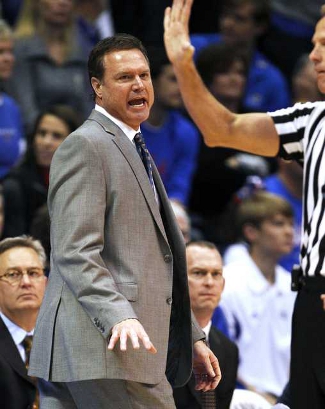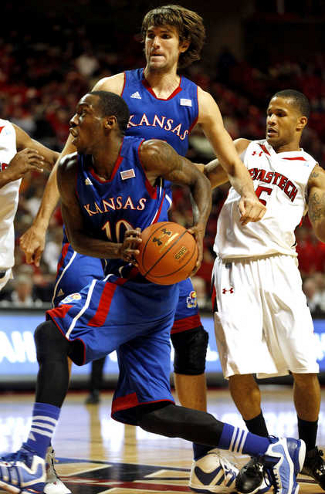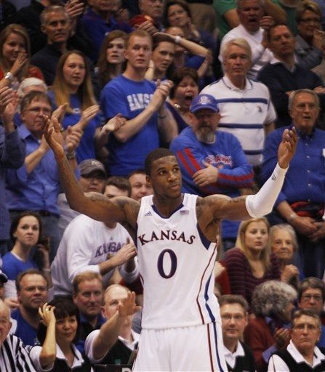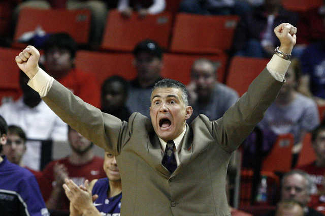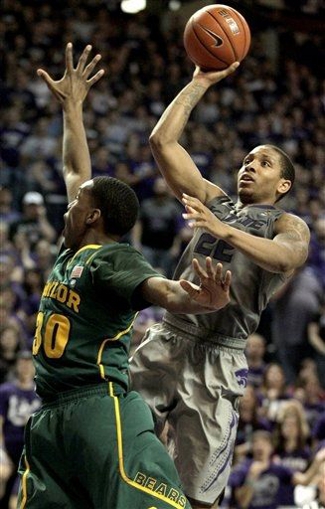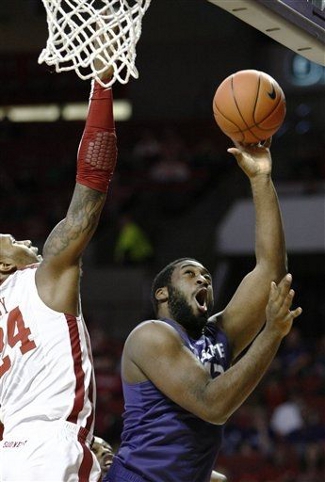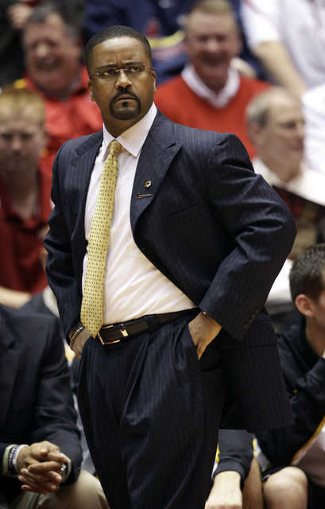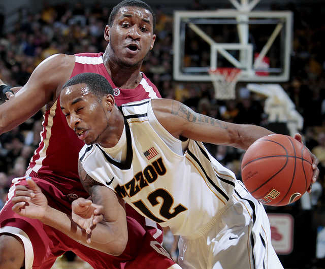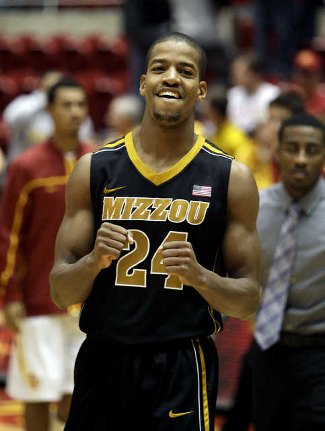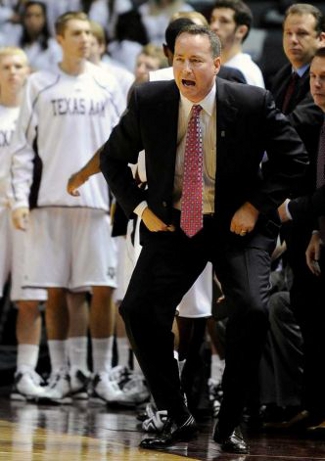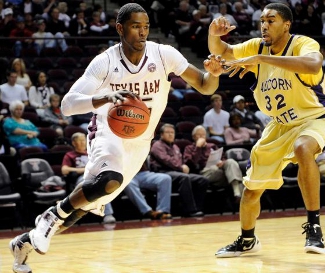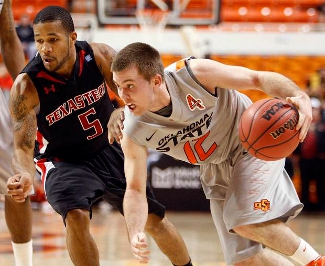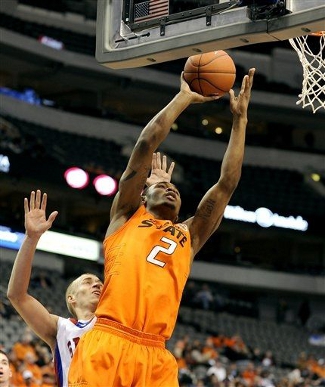Frank Erwin Center | Austin, TX | Tip: 3 P.M. CT | TV: CBS LRT Consecutive Game #205 The Longhorns return to the Erwin Center after a difficult two-game road trip, but simply returning to a friendly arena won’t make things any easier. This afternoon, Texas has the unenviable task of squaring off with the league-leading Kansas Jayhawks, who arrive in Austin on five days’ rest and riding high after an authoritative win over previously-undefeated Baylor. We’ve made much of the tough six-game stretch that Texas is currently in the midst of, but this afternoon marks the first of three home games out of the team’s next four contests. While knocking off Kansas, Iowa State, or Missouri won’t be easy — even at home — if the Longhorns are to add to their weak NCAA résumé, the Erwin Center is the most likely place to do it.
Bill Self has silenced the doubters this year The Jayhawks have won all three of their true road games so far this season, but all three wins came against rather weak competition. Southern Cal, Oklahoma, and Texas Tech have an average KenPom rank of 154 in D-I hoops, while the Longhorns currently check in at 25th in Pomeroy’s rankings. Kansas has knocked off big-name teams already this year in the likes of Georgetown, Ohio State, and Baylor, but none came in a true road environment. By the numbers For the last seven seasons, the Jayhawks have either won or shared the league’s regular season title, and have added five conference tournament championships during that same stretch. Many observers, myself included, thought that this year would be the season Kansas was finally knocked off of its throne atop the Big 12. Kansas lost four of five starters from last year’s Elite Eight team, but Bill Self has done a phenomenal coaching job to keep his team among the nation’s elite. Kansas is one of just three teams to have both their adjusted offensive and defensive efficiencies ranked in the top ten of Ken Pomeroy’s metrics. That unstoppable offense and suffocating defense add up to a scoring differential of +0.331 point per possession. Even in their first five conference games, which included contests against Baylor and Kansas State, the Jayhawks still have an impressive differential of +0.274. Kansas has a Player of the Year candidate in Thomas Robinson down low, and his imposing presence is a big reason why the Jayhawks have one of the nation’s five best marks in two-point field-goal defense. On offense, his dominance also has helped Kansas post a 54.4% shooting percentage inside the arc, and allowed the Jayhawks to reclaim 37.1% of their missed shots. When a team shoots as well as Kansas does and gets a lot of second and third chances, it is very difficult to get a stop. That rebounding advantage extends to the the other end of the court, as well, where the Jayhawks check in just outside the top 20 in defensive rebounding percentage. KU opponents snag just 27.5% of their offensive rebounding opportunities, making it very important for teams to be shooting well if they want to beat the ‘Hawks. Texas has actually done a very good job on the offensive glass so far this year, with a 39.7% mark that is 11th-best in the nation. If the Longhorns want to pull off the upset, they will have to continue to crash the glass and extend possessions against a tough Kansas D. Meet the Jayhawks When you introduce a guy as a contender for national Player of the Year, it goes without saying that he’s the star of his team. Already a dominant player as a sixth man last year, Thomas Robinson (No. 0) has taken over the role vacated by the Morris twins and has put up eye-popping numbers all season long. T-Rob has logged thirteen double-doubles on the year, and actually averages one as well, scoring 17.8 points and 12.3 rebounds per game. Lest you think those numbers were built against creampuff opponents, it should be pointed out that his stats are even better against Big 12 foes. In five conference games, Robinson is averaging 18 points and 12.6 boards. Robinson is nearly unstoppable on the glass, and has both a solid face-up game and quality post moves, making him a tough match-up for centers and and forwards of all types. The junior also can handle the ball pretty well, giving Kansas an additional player who can push the tempo and try to establish the break after turnovers and missed shots.
Tyshawn Taylor has been tough to stop this season The only returning starter from last year’s team is senior Tyshawn Taylor (No. 10), who has had an up-and-down career in Lawrence. After a win over Kansas State, Coach Self said of his point guard, “He makes plays you can’t coach. And then he makes plays where it looks like he’s never been coached.†That polarity has extended beyond the court, where Taylor has fought members of the football team, said he wanted to transfer on Facebook, and called out his critics on Twitter. Add all of those issues to the fact that sometimes Tyshawn struggles with turnovers, and there are times where the ever-obsessive Jayhawk Nation has been quite critical of their senior leader. Last season, Taylor put up double-digit scoring lines in sixteen games, including a masterful 20-point, five-assist effort that powered Kansas to revenge and a Big 12 tournament title against Texas. This year, he’s turned those flashes of brilliance into a consistent scoring threat, chipping in 16.2 points per game. Taylor can slice through the defense with the dribble, drills nearly 45% of his long-range attempts, and always seems to come up with big buckets in the clutch. Joining Taylor in the backcourt is Elijah Johnson (No. 15), who is also an adept ballhandler that can handle point duties. A highly-regarded recruit out of Las Vegas, Johnson struggled to find consistent playing time on an incredibly-loaded Kansas roster during his first two seasons. Now an everyday starter, he’s averaging nearly 10 points a game and provides excellent perimeter defense. While Johnson has only made 30% of his threes, he can heat up in a hurry, as evidenced by his 4-of-8 and 5-of-7 performances from long range against UCLA and Ohio State. The third guard for Coach Self is Travis Releford (No. 24) a redshirt junior who is yet another slashing threat in the backcourt. At 6’5″, he’s also a quality rebounder at the guard position, snagging more than four boards per game to go with his 10 points. Like Johnson, Releford also plays solid defense on the perimeter, using his height and length to frustrate other guards and post a steal percentage of 2.7%. In the middle, 7-footer Jeff Withey (No. 5) is the epitome of a role player. Playing only about 22 minutes per game, he still leads the Big 12 with more than three blocks per game and is a big part of Kansas’ dominance in the paint. Even when he’s not blocking shots, his simple presence in the lane can affect opposing offenses, and his 12.2% offensive rebounding percentage is tops on the team. One struggle for Withey this season has been foul trouble, but thanks to his limited minutes, he rarely actually fouls out of the game. The sixth man for Kansas is Connor Teahan (No. 2), who makes a living on the perimeter. Although he is not the team’s best three-point shooter, he still takes 80% of his shots from behind the arc, and has knocked down 37.5% of them so far this year. Texas has to stay close to the senior guard and make him drive the basketball. Unfortunately, the Jayhawks are great at moving the ball quickly and crisply, so sticking in Teahan’s shirt will be a difficult task. Kansas also uses a trio of reserves sparingly, getting a combined 26 minutes out of Kevin Young (No. 40), Justin Wesley (No. 4), and Naadir Tharpe (No. 1) in conference play. Young is an athletic forward who has rebounded very well after transferring from Loyola Marymount. Wesley is also a transfer forward, coming to Lawrence by way of Lamar. The younger brother of former Jayhawk Keith Langford, he’s a stout 6’8″, 220 pounds and excels at shot blocking. Tharpe will be the point guard of the future for KU and is extremely quick with the ball. For now, he is simply used to spell Taylor and Johnson for a few minutes each game. Keys to the game
Texas needs to keep Thomas Robinson on the sideline 1) Attack Robinson – There isn’t as much depth on this Jayhawk roster as in years past, and there’s certainly nobody on the bench who can match the skill level of Thomas Robinson. Texas benefited from getting K-State’s Jamar Samuels in foul trouble on Wednesday night, and they would see huge returns from doing the same against T-Rob this afternoon. The caveat here is that Myck Kabongo and J’Covan Brown must be smart about this approach, as both Robinson and Withey can easily block ill-advised shots. 2) Rattle Taylor – While Tyshawn has been a scoring machine as of late, he still has issues controlling the ball. When he is clicking and can dissect a defense, Kansas is practically unstoppable. The Longhorns must force Taylor into mistakes and keep him from feeling comfortable. If not, he and Robinson will likely put up video game numbers en route to an impressive road win. 3) Make it count behind the arc – Texas isn’t one of the best in the country when it comes to three-pointers, but against a stout interior D from Kansas, the Horns will have to knock down some outside shots. The Longhorns were a hot 9-of-16 from long range against Missouri last Saturday, but followed that up with an inefficient 7-of-22 against K-State on Wednesday. Brown was a big part of those long-range struggles against the Wildcats, so he and the Longhorns not only need to knock down their threes, but also make sure that they aren’t forcing up bad looks. 4) Build momentum early – The Frank Erwin Center has been more like a library the last two seasons, but the building has certainly been home to some electric atmospheres in the past, particularly when Kansas was in the house. Texas fans are the type to only cheer when given a reason to do so, which means the Horns need to come out hot if they want to get the full advantage of home court. Fall behind early — which is always a big danger against Kansas — and the apathetic Texas fanbase will likely start chatting about football recruiting news. |








